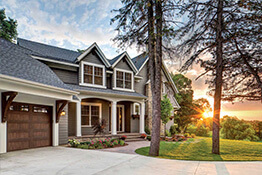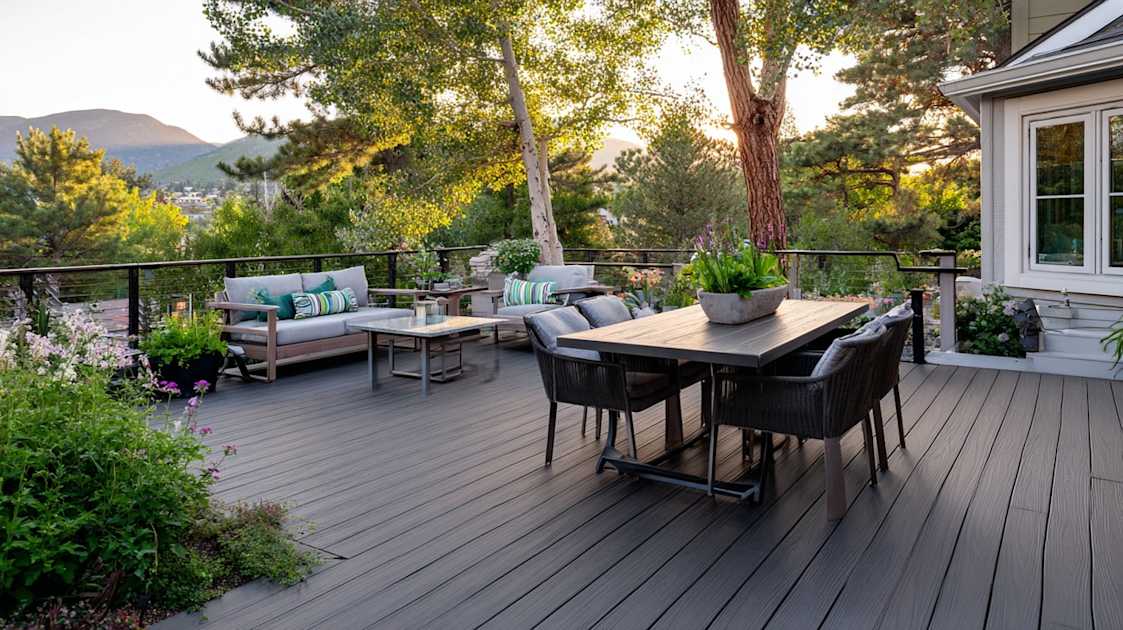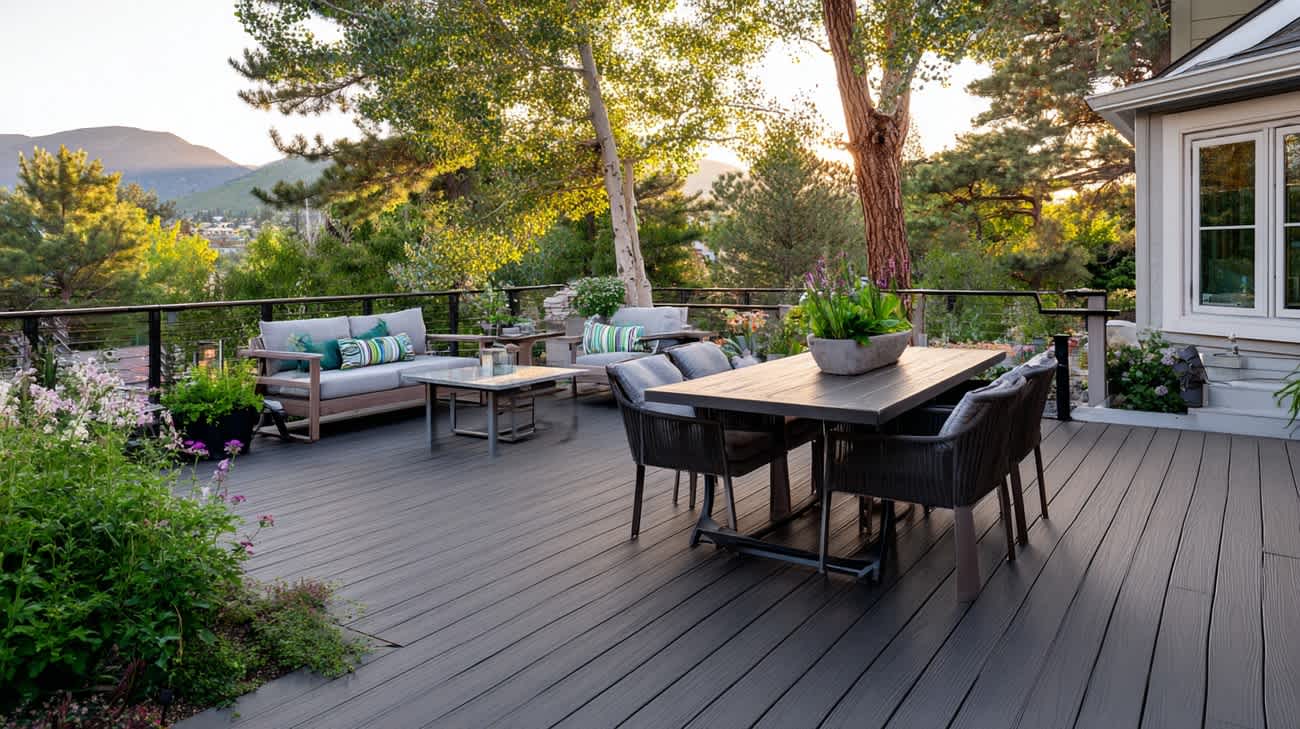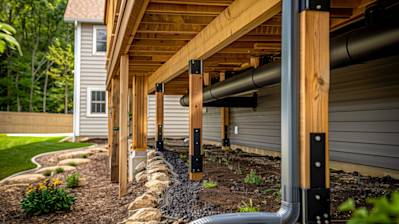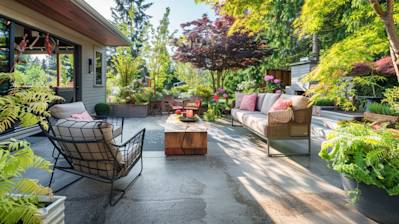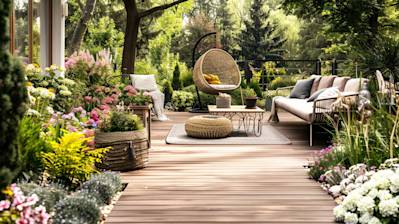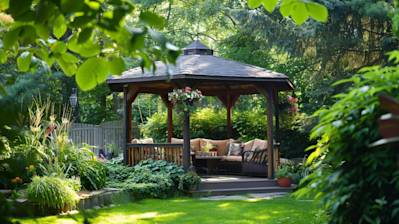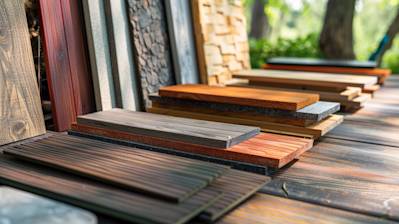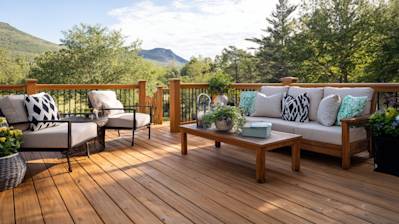If you're planning on enhancing your outdoor living space, choosing the best composite decking materials is crucial for crafting a beautiful, durable deck. Composite decking has gained immense popularity for its attractive appearance, longevity, and low-maintenance qualities. There's a perfect composite solution for every aesthetic and budget. Let's dive deep into the world of composite decking and explore the leading options and trends in the industry.
Understanding Composite Decking
Composite decking is a man-made building product that includes an approximate mix of recycled wood fibers, plastics, and bonding agents. This blend offers strength, resilience, and aesthetics that mimic the natural look of wood without all the drawbacks. It’s designed to endure the elements while resisting rot, mold, and fading—making it an excellent choice for all climates.
What Makes Composite Decking the Best Choice?
Composite decking brings a wealth of benefits to the table. Here's why it's the top choice for many homeowners:
- Low Maintenance: Say goodbye to the tedious sanding, staining, and painting that traditional wood requires. With composite decking, maintaining your deck is as simple as an occasional wash with soap and water.
- Weather Resistant: Whether you live in a rain-heavy region or an area with intense sun, the inherent resistance to moisture damage and UV rays keeps the deck looking new for years.
- Environmentally Friendly: Many composite decking options are crafted from recycled materials, making it a sustainable choice that reduces deforestation and waste.
- Variety of Styles: Composite decks come in a vast array of colors, textures, and finishes, permitting you to create a personalized look that complements your home’s exterior.
Top Composite Decking Brands
Choosing the right brand is vital to ensure that the decking lasts long and looks good through the years. Below is an exploration of some of the finest names in composite decking known for quality and innovation.
Trex
Trex is a pioneering brand recognized for crafting sustainable and high-performance alternative wood decking. Its diverse range of offerings includes basic to premium lines capable of fitting a variety of budgets. Trex is known for its durability, rich color palettes, and deep wood-grain patterns that match traditional wood aesthetics.
TimberTech
TimberTech is another industry leader, celebrated for its composite decking lines that simulate the timeless beauty of wood. The brand offers three main product lines— TimberTech AZEK, PRO, and EDGE—each designed with unique features. Their decking is famous for being scratch, mildew, and moisture-resistant.
Fiberon
Fiberon decking provides a high-end look at an affordable price. Fiberon’s boards are crafted for a natural wood look, and their durable nature withstands fading, staining, and mold, ensuring longevity. Being eco-friendly, Fiberon decking is made from 95% recycled content, partnering the aesthetic with a purpose.
Selecting the Right Composite Decking for Your Home
When selecting the ideal composite decking, consider factors such as your budget, desired look, and usage. Here's a quick guide to aid your decision-making process:
Budget Considerations
- Economy Lines: Often thinner and with fewer color options, these are perfect for budget-conscious projects.
- Mid-Range: Offers a balance between cost and added features like enhanced scratch and stain resistance.
- Premium: Provides top-tier aesthetics, additional fade resistance, and custom high-end finishes.
Style Preferences
Composite decking is available in a variety of textures that can redefine the look of your outdoor space.
- Smooth finishes for a modern, sleek look.
- Wood-grain patterns reminiscent of traditional timber for classic charm.
Performance Requirements
- High Traffic: Opt for thicker boards offering superior structural integrity.
- High Exposure to Sun: Choose options with enhanced UV protection.
Installation Considerations
Composite decking, while not overly complex to install, does demand some degree of precision and proper tools. Here are several pointers for ensuring optimal installation:
- Substructure Check: Ensure your existing substructure is robust enough for composite decking.
- Proper Spacing: Follow manufacturer directions on spacing for thermal expansion.
- Hidden Fasteners: Use hidden fasteners for a seamless look and better board stability.
Aesthetics and Color Trends
Modern composite decks embrace all shades—from earth-toned browns and reds to cool grays. Trending now are:
- Multicolor boards: Adding depth and dynamic looks.
- Earthy tones: Enabling seamless blending with natural landscapes.
- Cool Ashes and Slates: For those looking to embrace modern minimalism.
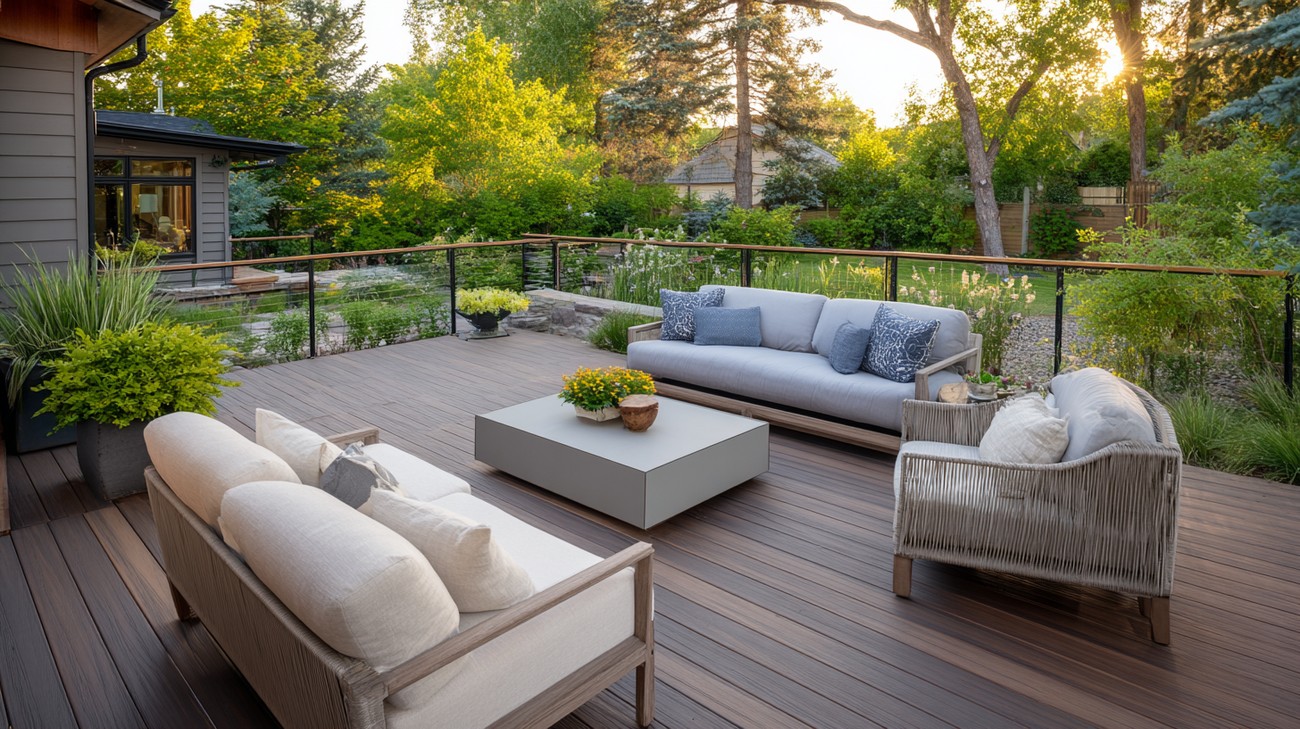
Frequently Asked Questions
How does composite decking handle different weather conditions?
Composite decking is designed to withstand various weather conditions, from harsh sun to heavy rain or snowfall. Its materials are engineered to resist fading, staining, and moisture penetration, which is particularly beneficial in preventing mold and mildew growth. This makes composite decks a fantastic choice for any climate, providing homeowners with a long-lasting outdoor space that maintains its beauty, regardless of the weather.
Can I install composite decking myself, or do I need a professional?
Installing composite decking can be a do-it-yourself project if you have some basic carpentry skills and the right tools. Many composite decking brands offer detailed installation guidelines and video tutorials to help you along the way. However, if you're not comfortable with handling tools and precise measurements, hiring a professional can ensure a flawless installation and save you time and potential headaches. Whether you choose DIY or professional installation, composite decks are designed to be relatively straightforward to assemble, making either option viable.
How should I clean and maintain my composite decking?
Maintaining composite decking involves simple steps to keep it looking its best. Regularly sweeping off dirt and debris will prevent surface stains. For deeper cleaning, a mild soap and water solution applied with a soft-bristle brush can effectively remove any spills or ground-in dirt. It's essential to avoid harsh chemicals and pressure washers, as they can damage the deck surface. In general, one or two thorough cleanings per year should suffice, keeping your deck fresh and attractive for years.
Is composite decking more expensive than wood?
Initially, composite decking can be more expensive than wood, but the cost difference balances out over time. The lower maintenance requirements mean you’ll save on the costs associated with staining, sealing, and replacing rotted or damaged wood. Composite decking's durability means fewer repairs and replacements, providing greater value over its lifespan. Additionally, the increase in property value with a well-maintained deck is another financial benefit that offsets the upfront cost of composite decking.
How environmentally friendly is composite decking?
Composite decking is considered environmentally friendly for several reasons. It is typically made from recycled materials, such as plastic and wood fibers, reducing landfill waste and the demand for virgin resources. By choosing composite materials instead of traditional wood, you contribute to deforestation mitigation. Many composite decking manufacturers strive to implement sustainable practices throughout their production processes, further enhancing their eco-friendly credentials.
Can composite decking be recycled?
Yes, composite decking can be recycled. While it's not as straightforward as recycling pure wood, many manufacturers have programs or partnerships with recycling facilities to ensure old composite decks are processed responsibly. The composite materials can be broken down and used in the creation of new decking materials or other products, contributing to a circular economy model. Consumers are encouraged to reach out to their decking supplier or local recycling facilities for specific guidance on recycling composite decking.
Are there color options available for composite decking, and do they fade over time?
Composite decking comes in a wide variety of color options, allowing homeowners to select shades that perfectly match their exterior decor and personal style. Advanced technologies and UV protection features in composite decking help maintain these colors over time, minimizing fading, even with direct sunlight exposure. By choosing high-quality composite decking options, you can enjoy long-lasting, vibrant hues that enhance your outdoor space's aesthetic appeal.
What is the weight capacity of composite decking, and can it support heavy furniture?
Composite decking is designed to support substantial weight, making it suitable for heavy furniture, planters, and even hot tubs. It provides reliable stability due to the density and strength of its materials. However, distributing the weight evenly across the deck is crucial to avoid any compromised structural integrity. If you plan to install significantly heavy items, consulting the decking manufacturer or a structural engineer can ensure that the load will be adequately supported.
Can composite decking be used for other outdoor structures, such as railings and stairs?
Yes, composite decking is versatile and can be used to construct various outdoor structures, including railings, stairs, and even pergolas. Its strength, resilience, and ease of maintenance make it an ideal material for these applications. Most manufacturers offer matching railing and accessory systems, allowing for a cohesive design that complements your composite deck, enhancing both its function and aesthetic appeal. ```

Comparison
When diving into the world of composite decking, it's essential to differentiate between the top contenders, each offering unique features, performance dynamics, pricing tiers, and ideal use cases. Here's a detailed comparison of some of the leading options in the composite decking market: Trex Transcend, Fiberon Paramount, TimberTech AZEK, and MoistureShield Vision.
Key Features Comparison
| Feature | Trex Transcend | Fiberon Paramount | TimberTech AZEK | MoistureShield Vision |
|---|---|---|---|---|
| Color Varieties | Multiple earth tones and tropics | Earthy tones and beach hues | Vast range of authentic colors | Natural wood colors |
| Texture | Deep wood grain patterns | Smooth texture with wood feel | Rich, varied realistic textures | Distinctive wood grain visuals |
| Fade and Stain Resistance | High | Excellent | Superior | Robust |
| Warranty Length | 25 years residential | 25 years residential | 50 years residential | 30 years residential and limited commercial |
Performance Differences
Trex Transcend: Known for its durability and resistance to fading and staining, Trex Transcend maintains its rich color over time and withstands the elements impressively. The deep wood grain pattern aids its aesthetic appeal while offering solid traction. Trex's innovative decking can endure high traffic and is perfect for those desiring minimal upkeep.
Fiberon Paramount: One of the key performance advantages here is that it's made from PVC, which gives it a robust resistance to moisture and allows it to perform well in wet and humid conditions. Its light weight makes it versatile for upper-level decks and docks. Fiberon's slip resistance is another notable attribute, great for poolside decks.
TimberTech AZEK: This product shines with the highest-end performance characteristics, offering premium resistance to fading, mold, and mildew. As a capped polymer decking, it’s less likely to absorb heat, ensuring a cooler surface during hot weather. TimberTech AZEK's superior backing in terms of warranty reflects the company’s confidence in its long-term durability.
MoistureShield Vision: Equipped with CoolDeck technology, MoistureShield Vision is meant to reduce heat absorption—a vital advantage in sunny climates. The brand stands out for its ability to be installed in the ground, on the ground, or underwater, a testament to its advanced moisture resistance.
Price Comparison
| Brand | Price per Square Foot |
|---|---|
| Trex Transcend | $10 - $12 |
| Fiberon Paramount | $11 - $14 |
| TimberTech AZEK | $13 - $18 |
| MoistureShield Vision | $10 - $15 |
Best Use Cases for Each
Trex Transcend: Ideal for homeowners looking for a broad selection of styles with minimal maintenance. Its robust nature suits family homes with heavy foot traffic.
Fiberon Paramount: Perfect for waterfront properties and those in humid areas. Also an excellent choice for elevated decks and lightweight structures.
TimberTech AZEK: Best for luxury builds and those looking for a long lifespan with unmatched resistance. It’s a top pick for regions with extreme weather variations.
MoistureShield Vision: Suited for homes in sunbelt areas or around water where heat reduction and moisture control are needed. Ideal for creative designs, including ground contact applications.
Bottom Line Recommendation
For a blend of style and economics, Trex Transcend appeals to homeowners seeking a balance between quality and affordability, with a robust line-up of design options. If your environment more commonly deals with dampness or includes pool spaces, Fiberon Paramount might be your best bet, thanks to its moisture-resilient constitution. TimberTech AZEK stands out for those willing to invest in premium decking with superior performance and a commitment to continuity in aesthetics and performance. Finally, if longevity with advanced moisture and heat management is crucial, particularly for custom installations, MoistureShield Vision offers unique technological advantages that make it worth considering.

Buyer's Guide: What to Look For in the Best Composite Decking
Choosing the right composite decking can transform your outdoor living space and elevate your home’s overall aesthetic. To help you navigate the myriad of options available, this guide will provide essential insights into key factors to consider, must-have versus nice-to-have features, red flags to watch out for, crucial questions to ask before purchasing, and tips on spotting quality products.
Key Factors to Consider
Material Composition: Composite decking is typically made from a mix of wood fibers and plastic materials. Look for boards with a balanced composition that offer both durability and a natural wood-like appearance. Some high-quality options use recycled materials, which is a bonus for eco-conscious buyers.
Durability and Strength: You'll want decking that withstands the elements and endures heavy foot traffic without fading, cracking, or warping. Check reviews and product specifications for assurances of long-term performance.
UV Resistance and Fade Protection: Sun exposure can cause inferior decking materials to fade quickly. Ensure the decking you choose offers UV protection, keeping its color vibrant and consistent over time.
Moisture and Mold Resistance: A great composite deck should resist moisture penetration, reducing the chance of mold and mildew growth, which is particularly important in humid climates.
Ease of Installation: Opt for products that offer straightforward installation systems or come with user-friendly guides. If you’re a DIY enthusiast, ensure the decking comes with easy-to-handle fixings and pre-drilled holes, if necessary.
Must-Have vs. Nice-to-Have Features
Must-Have Features:
- Slip Resistance: A slip-resistant surface is essential, especially around pool areas or during rainy conditions.
- Warranty: Look for a comprehensive warranty covering at least 25 years against structural failure and common defects.
- Low Maintenance: Composite decking should require minimal upkeep beyond occasional cleaning with soap and water.
Nice-to-Have Features:
- Variety of Colors and Textures: While not crucial, a range of colors and realistic textures can help achieve the exact look you envision.
- Hidden Fastening Systems: For a sleek, seamless appearance, hidden fasteners keep screws and nails out of sight.
- Eco-Friendliness: Products made from high percentages of recycled materials or offering recyclability can add environmental benefits.
Red Flags to Avoid
Limited Warranty: Beware of composite decking brands offering limited or short-term warranties, as this might indicate a lack of confidence in their product’s durability.
Inconsistent Board Quality: Watch for inconsistency in board sizes or colors, which can complicate installation and detract from the finished look.
Lack of Industry Certifications: Reputable products often come with certifications from recognized industry standards, which can guarantee certain aspects like fire resistance or environmental impact.
Questions to Ask Before Buying
What is the expected lifespan of the decking, and what maintenance, if any, is required to achieve this?
Does the decking have UV inhibitors to prevent fading, and how have they been tested?
Are there any specific cleaning products or practices recommended or prohibited for this decking?
How does the pricing of this decking compare with traditional wood options over its lifetime, considering maintenance costs?
How to Spot Quality
Product Reviews and Ratings: Dive into customer reviews and expert ratings. Pay particular attention to feedback on durability, appearance, and maintenance experience.
Sample Testing: Obtain samples of prospective decking materials. Evaluate their texture, weight, and feel, and try to scratch or stain them to test their resistance levels.
In-Person Inspection: Visit a showroom or see installations firsthand to assess how the product looks and performs in real-world settings.
Consultation with Experts: Speak with builders or experts who have installed composite decking. Their hands-on experiences can provide valuable insights into the product’s performance and ease of installation.
With this information, you’re now equipped to make an informed decision when selecting the best composite decking that will serve your needs for years to come. Happy decking!
Summary
The best composite decking really shines when you're looking for something that mixes great looks with durability. It offers a hassle-free outdoor space that's perfect for gatherings or just chilling with a book. With minimal upkeep required, you save both time and money in the long run. Plus, the eco-friendly options mean you can feel good about your choice. Whether you're redoing a small patio or building a grand deck, there's a composite decking option out there that fits your style and needs, making it a smart pick for countless homeowners.
Tags: durable, low-maintenance, high-quality,
